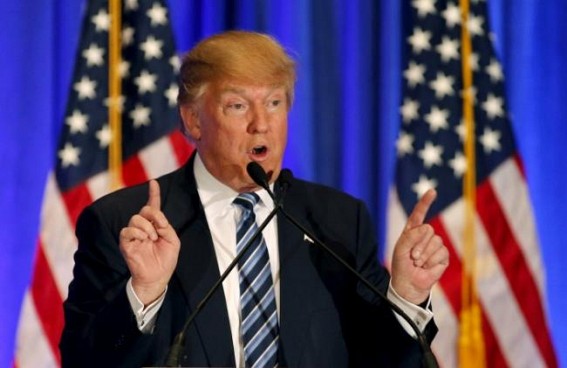Amulya Ganguli

PHOTO : TIWN
The similarities between the views of Donald Trump, the Republican Party hopeful in the US presidential campaign, and the BJP hawks in India are too obvious to be ignored.
Like all those belonging to the ultra-right, their primary animus is against the "outsider" in terms of ethnicity or religion. In venting their anger against the menacing "alien", they arouse the primordial fears which guided primitive communities living in isolated ghettos. These herd instincts have survived centuries of social and scientific progress.
The followers of Trump and the BJP hardliners share a deep dislike for Muslims, bordering on paranoia. If, for the Republican (who, ironically, is an outsider in his own party), the antipathy for the Muslims is a fallout of 9/11, for the BJP extremists, it is a built-in feature of their worldview, dating to the formation of the RSS nine decades ago.
The aversion for outsiders is also reflected in tirades against immigrants, especially non-whites, which is a feature of other right-wing parties in Europe like Marine Le Pen's National Front in France and Alternative for Germany (Alternative fur Deutschland).
In Trump's case, Mexicans are the primary villains; for BJP it is the intruders from Bangladesh. Related to this influx is the fear that in course of time, the demographic composition of the two countries will change with the present majority communities - the WASPs (White Anglo-Saxon Protestants) in the US and the Hindus in India being supplanted by the Browns (Mexicans, Puerto Ricans) in America and the Muslims in India.
Supporters of Trump point out that he reflects the anger at the grassroots against an insensitive establishment, whose striving for political correctness leads to handling the newcomers with kid gloves in keeping with America's 19th century pledge - "give me your tired, your poor, your huddled masses" - although the invitation was for White refugees from Europe.
Similarly, both the hardliners and the moderates in the BJP accuse the Congress governments of the past with following a policy of minority "appeasement" to coddle the Muslims to use them as a vote bank. According to them, it is this favouritism which has made the long-suffering Hindus turn in increasing numbers to the BJP.
Critics of Trump and the BJP hardliners see in these attitudes disturbing signs of fascistic tendencies which seek to reduce the minorities to the status of second class citizens. What is noteworthy, however, is that while the BJP as a party and Narendra Modi as the prime minister have recognized the need to tone down an anti-minority outlook, Trump shows no such inclination. Indeed, it is very likely that in the aftermath of the Brussels outrage, he will harden his stance against the Muslims.
The reason why the Muslims - and sometimes also the Sikhs because of their beards - are targeted in the US is that they have never constituted an integral part of American society unlike in India where the Hindus have lived together with various minorities - Muslims, Christians, Sikhs, Jains, Parsis and others - for centuries.
In contrast, America's WASP mindset is different. Having very nearly exterminated the Native Americans or Red Indians, they fought a long battle with the African Americans or the Blacks in order to keep them in virtual bondage. To this day, when the US has a Black President, the community's legitimacy as true Americans is questioned by the red necks.
Trump's emergence represents the rise of these boorish elements who feel that the dominance of the Whites is under threat. Before him, there were White supremacist groups such as the Ku Klux Klan and others who regarded the Washington insiders of the so-called beltway as usurpers. It is this aspect of Trump's policies which can prove to be his Achilles heel, for extremism is rarely successful as a political ploy.
In India, mercifully, the BJP developed its own antidote to majoritarian bigotry in the person of Modi, who realized some time after the 2002 Gujarat riots that a country cannot be governed by alienating a sizable section of the population.
From the provocative anti-minority politics of the 1990s, therefore, when a 16th century mosque was demolished by the BJP's supporters, leading to countrywide riots, Modi today is following the policy of development for all - sabka saath, sabka vikas - and trying to restrain the hotheads.
That he is not always successful is understandable. After all, he is up against in-built anti-minority prejudices in the saffron brotherhood. The violent biases not only come to the fore in the event of rumours of beef being consumed but also when the party is engaged in battling the "anti-nationals" as among the Jawaharlal Nehru University (JNU) students.
On such an occasion, a saffron activist can say: "humney Graham Staines ko jinda jalaya, iss bar Kanhaiya ki bari hai (we burnt alive Graham Staines, now it is Kanhaiya's turn). Staines was a Christian missionary who was burnt alive in Odisha in 1996 and Kanhaiya Kumar is a JNU student leader.
The activist can be said to have trumped even Trump with his virulence. But he is unlikely to be allowed to run for an official position in a saffron outfit, let alone be a presidential candidate. That is India's saving grace, thanks to the nation's long history of tolerance dating to Emperor Asoka (273-232 BC).
(Amulya Ganguli is a political analyst. The views expressed are personal. He can be reached at amulyaganguli@gmail.com )
- Why Modi’s BJP swept key India regional elections
- TIWN’s landmark legal victory against BJP Govt’s Illegal attacks to shutdown fearless Media
- India to be world's third-largest economy by 2030 -S&P Global Ratings
- Tripura's Dark Era : Mafia style Brutal attacks on Journalists, fight for your Citizen rights !
- How to access tripurainfoway.com via HOLA from India



